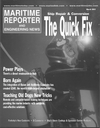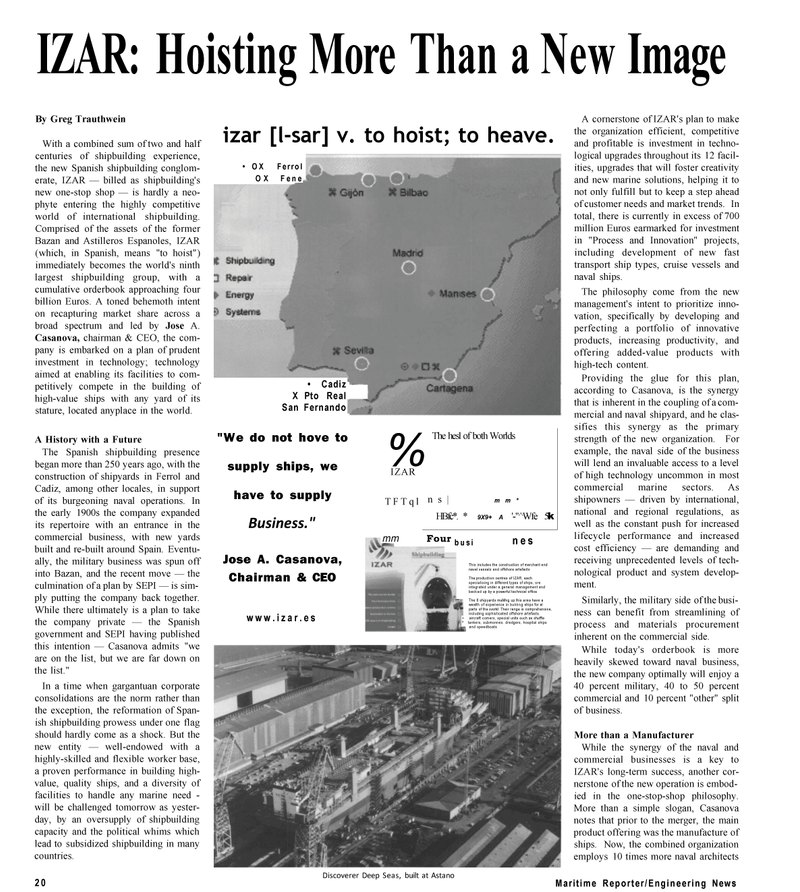
Page 20: of Maritime Reporter Magazine (March 2001)
Read this page in Pdf, Flash or Html5 edition of March 2001 Maritime Reporter Magazine
IZAR: Hoisting More Than a New Image
By Greg Trauthwein
With a combined sum of two and half centuries of shipbuilding experience, the new Spanish shipbuilding conglom- erate, IZAR — billed as shipbuilding's new one-stop shop — is hardly a neo- phyte entering the highly competitive world of international shipbuilding.
Comprised of the assets of the former
Bazan and Astilleros Espanoles, IZAR (which, in Spanish, means "to hoist") immediately becomes the world's ninth largest shipbuilding group, with a cumulative orderbook approaching four billion Euros. A toned behemoth intent on recapturing market share across a broad spectrum and led by Jose A.
Casanova, chairman & CEO, the com- pany is embarked on a plan of prudent investment in technology; technology aimed at enabling its facilities to com- petitively compete in the building of high-value ships with any yard of its stature, located anyplace in the world.
A History with a Future
The Spanish shipbuilding presence began more than 250 years ago, with the construction of shipyards in Ferrol and
Cadiz, among other locales, in support of its burgeoning naval operations. In the early 1900s the company expanded its repertoire with an entrance in the commercial business, with new yards built and re-built around Spain. Eventu- ally, the military business was spun off into Bazan, and the recent move — the culmination of a plan by SEPI — is sim- ply putting the company back together.
While there ultimately is a plan to take the company private — the Spanish government and SEPI having published this intention — Casanova admits "we are on the list, but we are far down on the list."
In a time when gargantuan corporate consolidations are the norm rather than the exception, the reformation of Span- ish shipbuilding prowess under one flag should hardly come as a shock. But the new entity — well-endowed with a highly-skilled and flexible worker base, a proven performance in building high- value, quality ships, and a diversity of facilities to handle any marine need - will be challenged tomorrow as yester- day, by an oversupply of shipbuilding capacity and the political whims which lead to subsidized shipbuilding in many countries. 20 izar [l-sar] v. to hoist; to heave. • OX Ferrol
OX Fene • Cadiz
X Pto Real
San Fernando "We do not hove to supply ships, we have to supply
Business."
Jose A. Casanova,
Chairman & CEO www.izar.es %
IZAR
The hesl of both Worlds
TFTql ns| mm*
HBfc*. * 9X9+ A '-"^Wfe 5k mm Four busi nes
This includes the construction of merchant end navel vessels end offshore artefacts
The production centres of IZAR, each specialising in different types of ships, ore integrated under a general management end backed up by a powerful technical office
The 8 shipyards maMng up this area have a wealth of experience in bukkng ships for al parts of the xvortd Their range is comprehensive, including sophisticated offshore artefacts. • aircraft comers, special units such as shuffle ^ tankers, submonnes. dredgers, hospital ships - and speedboats
Discoverer Deep Seas, built at Astano
A cornerstone of IZAR's plan to make the organization efficient, competitive and profitable is investment in techno- logical upgrades throughout its 12 facil- ities, upgrades that will foster creativity and new marine solutions, helping it to not only fulfill but to keep a step ahead of customer needs and market trends. In total, there is currently in excess of 700 million Euros earmarked for investment in "Process and Innovation" projects, including development of new fast transport ship types, cruise vessels and naval ships.
The philosophy come from the new management's intent to prioritize inno- vation, specifically by developing and perfecting a portfolio of innovative products, increasing productivity, and offering added-value products with high-tech content.
Providing the glue for this plan, according to Casanova, is the synergy that is inherent in the coupling of a com- mercial and naval shipyard, and he clas- sifies this synergy as the primary strength of the new organization. For example, the naval side of the business will lend an invaluable access to a level of high technology uncommon in most commercial marine sectors. As shipowners — driven by international, national and regional regulations, as well as the constant push for increased lifecycle performance and increased cost efficiency — are demanding and receiving unprecedented levels of tech- nological product and system develop- ment.
Similarly, the military side of the busi- ness can benefit from streamlining of process and materials procurement inherent on the commercial side.
While today's orderbook is more heavily skewed toward naval business, the new company optimally will enjoy a 40 percent military, 40 to 50 percent commercial and 10 percent "other" split of business.
More than a Manufacturer
While the synergy of the naval and commercial businesses is a key to
IZAR's long-term success, another cor- nerstone of the new operation is embod- ied in the one-stop-shop philosophy.
More than a simple slogan, Casanova notes that prior to the merger, the main product offering was the manufacture of ships. Now, the combined organization employs 10 times more naval architects
Maritime Reporter/Engineering News

 19
19

 21
21
